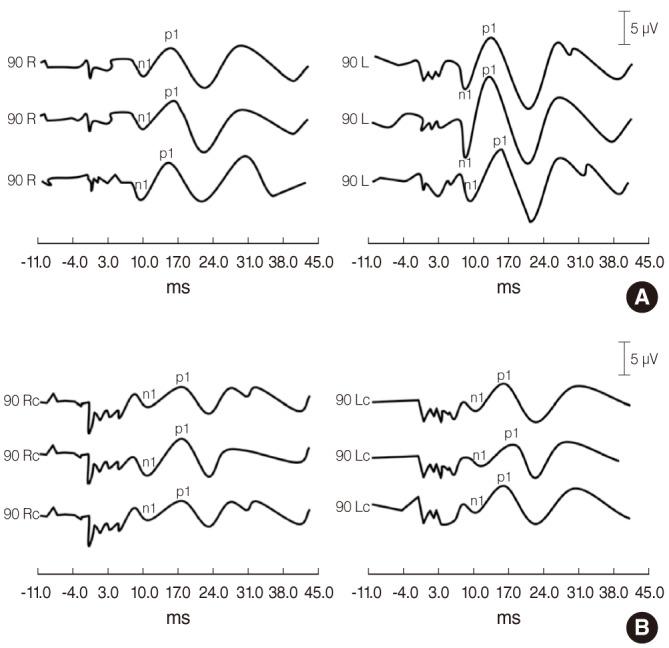Clin Exp Otorhinolaryngol.
2012 Dec;5(4):188-193. 10.3342/ceo.2012.5.4.188.
The Efficiency of Simultaneous Binaural Ocular Vestibular Evoked Myogenic Potentials: A Comparative Study with Monaural Acoustic Stimulation in Healthy Subjects
- Affiliations
-
- 1Department of Otolaryngology-Head and Neck Surgery, Kangbuk Samsung Hospital, Sungkyunkwan University School of Medicine, Seoul, Korea. miphy87@naver.com
- KMID: 1489077
- DOI: http://doi.org/10.3342/ceo.2012.5.4.188
Abstract
OBJECTIVES
To evaluate the test-retest reliability and convenience of simultaneous binaural acoustic-evoked ocular vestibular evoked myogenic potentials (oVEMP).
METHODS
Thirteen healthy subjects with no history of ear diseases participated in this study. All subjects underwent oVEMP test with both separated monaural acoustic stimulation and simultaneous binaural acoustic stimulation. For evaluating test-retest reliability, three repetitive sessions were performed in each ear for calculating the intraclass correlation coefficient (ICC) for both monaural and binaural tests. We analyzed data from the biphasic n1-p1 complex, such as latency of peak, inter-peak amplitude, and asymmetric ratio of amplitude in both ears. Finally, we checked the total time required to complete each test for evaluating test convenience.
RESULTS
No significant difference was observed in amplitude and asymmetric ratio in comparison between monaural and binaural oVEMP. However, latency was slightly delayed in binaural oVEMP. In test-retest reliability analysis, binaural oVEMP showed excellent ICC values ranging from 0.68 to 0.98 in latency, asymmetric ratio, and inter-peak amplitude. Additionally, the test time was shorter in binaural than monaural oVEMP.
CONCLUSION
oVEMP elicited from binaural acoustic stimulation yields similar satisfactory results as monaural stimulation. Further, excellent test-retest reliability and shorter test time were achieved in binaural than in monaural oVEMP.
Keyword
MeSH Terms
Figure
Reference
-
1. Welgampola MS, Colebatch JG. Characteristics and clinical applications of vestibular-evoked myogenic potentials. Neurology. 2005; 5. 64(10):1682–1688. PMID: 15911791.
Article2. Murofushi T, Halmagyi GM, Yavor RA, Colebatch JG. Absent vestibular evoked myogenic potentials in vestibular neurolabyrinthitis: an indicator of inferior vestibular nerve involvement? Arch Otolaryngol Head Neck Surg. 1996; 8. 122(8):845–848. PMID: 8703387.
Article3. Colebatch JG, Halmagyi GM, Skuse NF. Myogenic potentials generated by a click-evoked vestibulocollic reflex. J Neurol Neurosurg Psychiatry. 1994; 2. 57(2):190–197. PMID: 8126503.
Article4. Todd NP, Rosengren SM, Aw ST, Colebatch JG. Ocular vestibular evoked myogenic potentials (OVEMPs) produced by air- and bone-conducted sound. Clin Neurophysiol. 2007; 2. 118(2):381–390. PMID: 17141563.
Article5. Iwasaki S, McGarvie LA, Halmagyi GM, Burgess AM, Kim J, Colebatch JG, et al. Head taps evoke a crossed vestibulo-ocular reflex. Neurology. 2007; 4. 68(15):1227–1229. PMID: 17420408.
Article6. Rosengren SM, McAngus Todd NP, Colebatch JG. Vestibular-evoked extraocular potentials produced by stimulation with bone-conducted sound. Clin Neurophysiol. 2005; 8. 116(8):1938–1948. PMID: 15979939.
Article7. Manzari L, Burgess AM, Curthoys IS. Dissociation between cVEMP and oVEMP responses: different vestibular origins of each VEMP? Eur Arch Otorhinolaryngol. 2010; 9. 267(9):1487–1489. PMID: 20582703.
Article8. Curthoys IS, Kim J, McPhedran SK, Camp AJ. Bone conducted vibration selectively activates irregular primary otolithic vestibular neurons in the guinea pig. Exp Brain Res. 2006; 11. 175(2):256–267. PMID: 16761136.
Article9. Suzuki JI, Tokumasu K, Goto K. Eye movements from single utricular nerve stimulation in the cat. Acta Otolaryngol. 1969; 10. 68(4):350–362. PMID: 5309166.
Article10. Todd NP. The origin of the ocular vestibular evoked myogenic potential (OVEMP). Clin Neurophysiol. 2010; 6. 121(6):978–980. PMID: 20202896.
Article11. Wang SJ, Jaw FS, Young YH. Ocular vestibular-evoked myogenic potentials elicited from monaural versus binaural acoustic stimulations. Clin Neurophysiol. 2009; 2. 120(2):420–423. PMID: 19097934.
Article12. Rosengren SM, Welgampola MS, Colebatch JG. Vestibular evoked myogenic potentials: past, present and future. Clin Neurophysiol. 2010; 5. 121(5):636–651. PMID: 20080441.
Article13. Nguyen KD, Welgampola MS, Carey JP. Test-retest reliability and age-related characteristics of the ocular and cervical vestibular evoked myogenic potential tests. Otol Neurotol. 2010; 7. 31(5):793–802. PMID: 20517167.
Article14. Maes L, Vinck BM, De Vel E, D'haenens W, Bockstael A, Keppler H, et al. The vestibular evoked myogenic potential: a test-retest reliability study. Clin Neurophysiol. 2009; 3. 120(3):594–600. PMID: 19136296.
Article15. Isaradisaikul S, Strong DA, Moushey JM, Gabbard SA, Ackley SR, Jenkins HA. Reliability of vestibular evoked myogenic potentials in healthy subjects. Otol Neurotol. 2008; 6. 29(4):542–544. PMID: 18520588.
Article16. Versino M, Colnaghi S, Callieco R, Cosi V. Vestibular evoked myogenic potentials: test-retest reliability. Funct Neurol. 2001; Oct-Dec. 16(4):299–309. PMID: 11853320.17. Curthoys IS. A critical review of the neurophysiological evidence underlying clinical vestibular testing using sound, vibration and galvanic stimuli. Clin Neurophysiol. 2010; 2. 121(2):132–144. PMID: 19897412.
Article18. Welgampola MS. Evoked potential testing in neuro-otology. Curr Opin Neurol. 2008; 2. 21(1):29–35. PMID: 18180649.
Article
- Full Text Links
- Actions
-
Cited
- CITED
-
- Close
- Share
- Similar articles
-
- The Optimization of Galvanic Vestibular Stimulation according to Evoked Nystagmus
- Ocular Vestibular Evoked Myogenic Potential in Healthy Subjects: A Comparative Study with Cervical Vestibular Evoked Myogenic Potential
- The Principle and Methodology of Vestibular Evoked Myogenic Potential
- Vestibular-Evoked Myogenic Potentials: Sound- and Bone-Conducted Stimuli and Clinical Applications
- Ocular Vestibular Evoked Myogenic Potentials Produced by Stimulation With Bone-conducted Vibration in Healthy Subjects



